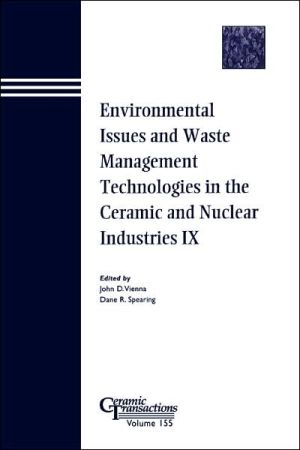

 |

|

Sold Out
Book Categories |
Ceramics For Waste or Nuclear Applications.
Uranium Valences in Perovskite CaTiO3 (E.R. Vance, M.L. Carter, Z. Zhang, K.S. Finnie, S.J. Thomson, B.D. Begg).
Iron-Substituted Barium Hollandite Ceramics for Cesium Immobilization (F. Bart, G. Leturcq, H. Rabiller).
Hollandite-Rich Titanate Ceramics Prepared by Melting in Air (M.L. Carter, E.R. Vance, H. Li).
Hyperfine Interaction Study of Short Range Order in Zircon (H. Jaeger, K. Pletzke, J.M. Hanchar).
Scale-Up of Lithium Aluminate Pellet Manufacturing with a Flowable Powder (G. Hollenberg, L. Bagaassen, R. Kurosky, D. Tonn, W. Carty).
Melter Processing and Process Monitoring.
Laboratory Measurement of Glass Melting Rate (D.F. Bickford).
Analysis of Feed Melting Processes (J. Matyas, P. Hrma, D.-S. Kim).
Electron Equivalents Redox Model for High Level Waste Vitrification (C.M. Jantzen, D.C. Koopman, C.C. Herman, J.B. Pickett, J.R. Zamecnik).
Sulfate Retention during Waste Glass Melting (P. Hrma, J.D. Vienna, W.C. Buchmiller, J.S. Ricklefs).
The Characterization and Dissolution of High Level Waste Calcine in Alkali Borosilicate Glass (S. Morgan, P.B. Rose, R.J. Hand, N.C. Hyatt, W.E. Lee, C.R. Scales).
Summary of Results from 786-A Minimelter Run with Marcobatch 3 (Sludge Batch 2) Baseline Feed Using Frit 320 (M.E. Smith, D.H. Miller).
Numerical Models of Waste Glass Melters Part I-Lumped Parameter Analysis of DWPF (H.N. Guerrero, D.F. Bickford).
Numerical Models of Waste Glass Melters Part II-Computational Modeling of DWPF (H.N. Guerrero, D.F. Bickford, H. Naseri-Neshat).
Tailored Electrical Driving as a Means of Controlling Heat Distribution and Convection Patterns in Joule-Heated Waste Glass Melters (J.A. Fort, D.L. Lessor).
Effects of Poly(Acrylic Acid) on the Rheological Properties of Aqueous Melter Feed Slurries for Nuclear Waste Vitrification (H. Zhao, I.S. Muller, I.L. Pegg).
Frequency Modulated Continuous Wave Monitoring of Refractory Walls (B. Varghese, R. Zoughi, C. DeConink, M. Velez, R. Moore).
Combustion Control Experimentations at a Pilot Scale Glass Furnace (S. Keyvan, R.A. Rossow, M. Velez, W.L. Headrick, R.E. Moore, C. Romero).
Waste Vitrification Programs.
Completion of the Vitrification Campaign at the West Valley Demonstration Project (R.A. Palmer, H.M. Houston, A.J. Misercola).
Review of the French Vitrification Program (R. Do Quang, P. Mougnard, C. Ladirat, A. Prodhomme).
Examination of DWPF Melter Materials After 8 Years of Service (D.C. Iverson, K.J. Imrich, D.F. Bickford, J.T. Gee, C.F. Jenkins, F.M. Heckendorn).
Testing to Demonstrate Regulatory Compliance of Glass Waste Forms for Immobilization of Radioactive Wastes at the Hanford Site (D.B. Blumenkranz, S. Kelly, D.J. Swanberg, C.A. Musick).
Cold Crucible Induction-Heated Melter Test Results with Surrogate DOE High-Level Wastes (C.C. Herman, D.F. Bickford, D.K. Peeler, R. Goles, J.D. Vienna, A. Aloy, S. Stafanovsky, D. Gombert, J. Richardson).
Crucible-Scale Vitrification Studies with Hanford Tank AZ-102 High Sulfate-Containing Low Activity Waste (C.L. Crawford, R.F. Schumacher, D.M. Ferrara, N.E. Bibler).
Glass Formulation and Property Models.
Preliminary Glass Development and Testing for In-Container Vitrification of Hanford Low-Activity Waste (J.D. Vienna, D.-S. Kim, M.J. Schweiger, P. Hrma, J. Matyás, J.V. Crum, D.E. Smith).
Evaluation of Melt Rate through Higher Waste Loading (T.H. Lorier, P.S. McGrier).
Spinel Crystallization in HLW Glass Melts: Cation Exchange Systematics and the Role of Rh2O3 in Spinel Formation (S. Annamalai, H. Gan, M. Chaudhuri, W.K. Kot, I.L. Pegg).
Composition Effects on the Vapor Hydration of Waste Glasses (A.C. Buechele, F. Lofaj, I.S. Muller, C.T.F. Mooers, I.L. Pegg).
Glass Composition-TCLP Response Model for Waste Glasses (D.-S. Kim, J.D. Vienna).
Alternate Waste Forms and Processes.
Iron Phosphate Glass for Immobilization of Hanford LAW (C.W. Kim, D. Zhu, D.E. Day, D.-S. Kim, J.D. Vienna, D.K. Peeler, T.E. Day, T. Neidt).
Characterization and Performance of Fluidized Bed Steam Reforming (FBSR) Product as a Final Waste Form (C.M. Jantzen).
Microstructure of Emulsion-Based Polymeric Waste Forms for Encapsulating Low-Level, Radioactive and Toxic Metal Wastes (R. Evans, A. Quach, G. Xia, B.J. Zelinski, W.P. Ela, D.P. Birnie III, A.E. Sáez, H.D. Smith, G.L. Smith).
Leach Resistance of Encapsulated Salts in Polymeric Waste Forms Fabricated Using an Aqueous-Based Route (A. Quach, G. Xia, R. Evans, A.E. Sáez, B.J. Zelinski, H. Smith, G. Smith, D.P. Birnie III, W.P. Ela).
Thermal Processing Optimization for Simulated Hanford Waste Glass (AZ 101) (A. Giordana, W.G. Ramsey, T.F. Meaker, B. Kauffman, M. McCarthy, K. Guilbeau, J.D. Smith, F.S. Miller, T. Sanders, E.W. Bohannan, J. Powell, M. Reich, J. Jordan, L. Ventre, R.E. Barletta, A.A. Ramsey, G. Maise, B. Manowitz, M. Steinberg, F. Salzano).
Aging Behavior of a Sodalite Based Ceramic Waste Form (J.F. Jue, S.M. Frank, T.P. OHolleran, T.L. Barber, S.G. Johnson, K.M. Goff, W. Sinkler).
Process for Selective Removal and Concentration of Actinides and Heavy Metals from Water by B.P. Kiran, A.W. Apblett).
Login|Complaints|Blog|Games|Digital Media|Souls|Obituary|Contact Us|FAQ
CAN'T FIND WHAT YOU'RE LOOKING FOR? CLICK HERE!!! X
 You must be logged in to add to WishlistX
 This item is in your Wish ListX
 This item is in your CollectionEnvironment Issues #9 Ct V 155, Vol. 155
X
 This Item is in Your InventoryEnvironment Issues #9 Ct V 155, Vol. 155
X
 You must be logged in to review the productsX
 X
 X

Add Environment Issues #9 Ct V 155, Vol. 155, In today's world of increasingly stringent environmental regulations, it is critical to identify and adequately address environmental issues in the ceramic industry to ensure success. In addition, ceramics and glasses play a critical role in the nuclear i, Environment Issues #9 Ct V 155, Vol. 155 to the inventory that you are selling on WonderClubX
 X

Add Environment Issues #9 Ct V 155, Vol. 155, In today's world of increasingly stringent environmental regulations, it is critical to identify and adequately address environmental issues in the ceramic industry to ensure success. In addition, ceramics and glasses play a critical role in the nuclear i, Environment Issues #9 Ct V 155, Vol. 155 to your collection on WonderClub |